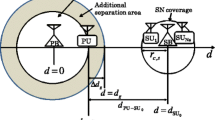Abstract
This paper focuses on where to place the secondary base station (SBS) so as to obtain the maximum coverage area for a broadcasting cognitive radio network with spectrum underlay. Aiming to solve this problem, the coverage area is first obtained, considering the interference constraints for the primary user (PU) and quality of service constraints for the secondary user. It is found that the location of the SBS takes an important role in the coverage area determination. Then, an optimal location of the SBS is derived to maximize the coverage area in the broadcasting cognitive radio network. Further, considering the local environment can largely determine the characteristics of radio propagation in practice, a typical scenario with an obstacle located between the PU and SBS is analyzed. Numerical results show that the optimal location of the SBS is different with different locations of the obstacle, and will converge to a fixed point as the distance between the PU and the obstacle increases when the obstacle is assumed to be a hill, which is exactly the optimal location of the SBS without the obstacle.





Similar content being viewed by others
References
Simon, H. (2005). Cognitive radio: Brain-empowered wireless communications. IEEE Journal on Selected Areas in Communications, 23(2), 201–220.
Ajay, S., Manav, R. B., & Ranjan, K. M. (2012). Cooperative spectrum sensing in multiple antenna based cognitive radio network using an improved energy detector. IEEE Communications Letters, 16(1), 64–67.
Akyildiz, I. F., Won-Yeol, Lee, Vuran, M. C., & Mohanty, S. (2008). A survey on spectrum management in cognitive radio networks. IEEE Communications Magazine, 46(4), 40–48.
Le, Long Bao, & Hossain, E. (2008). Resource allocation for spectrum underlay in cognitive radio networks. IEEE Transactions on Wireless Communications, 7(12), 5306–5315.
Senthuran, S., Anpalagan, A., & Das, O. (2012). Throughput analysis of opportunistic access strategies in hybrid underlay-overlay cognitive radio networks. IEEE Transactions on Wireless Communications, 11(6), 2024–2035.
Chakravarthy, V., Li, X., Wu, Z., Temple, M., Garber, F., Kannan, R., et al. (2009). Novel overlay/underlay cognitive radio waveforms using SD-SMSE framework to enhance spectrum efficiency part I: Theoretical framework and analysis in AWGN channel. IEEE Transactions on Communications, 57(12), 3794–3804.
Hong, J. P., Bi, H., Tae, W. B., & Wan, C. (2012). On the cooperative diversity gain in underlay cognitive radio systems. IEEE Transactions on Communications, 60(1), 209–219.
Goldsmith, A., Jafar, S. A., Marić, I., & Srinivasa, S. (2009). Breaking spectrum gridlock with cognitive radios: An information theoretic perspectiveve. Proceedings of the IEEE, 97(5), 894–914.
Neham, E. A. (1974). An approach to estimating land mobile radio coverage. IEEE Transactions on Vehicular Technology, 23(4), 135–138.
Chan, G. K. (1991). Propagation and coverage prediction for cellular radio systems. IEEE Transactions on Vehicular Technology, 40(4), 665–670.
Cheung, K. W., & Murch, R. D. (1998). Optimising indoor base-station locations in coverage-and interference-limited indoor environments. IEE Proceedings Communications, 145(6), 445–450.
Wang, Y., Si, Y., & Leung, H. (2010). A novel inversion method for outdoor coverage prediction in wireless cellular network. IEEE Transactions on Vehicular Technology, 59(1), 36–47.
Xin, Q., Wang, X., Cao, J. N., & Feng, W. (2011). Joint admission control. Channel assignment and QoS routing for coverage optimization in multi-hop cognitive radio cellular networks. IEEE international conference on mobile Ad-Hoc and sensor systems. doi:10.1109/MASS.2011.17.
Alberto, R., Carlo, M., & Fernando, P. (2012). Overlay spectrum reuse in a multicarrier broadcast network: Coverage analysis. IEEE International Workshop on Signal Processing Advances in Wireless Communications (SPAWC). doi:10.1109/SPAWC.2012.6292889.
Wang, L.-C., & Chen, A. (2009). Effects of location awareness on concurrent transmissions for cognitive Ad Hoc networks overlaying infrastructure-based systems. IEEE Transactions on Mobile Computing, 8(5), 577–589.
Rappaport, T. S. (2002). Wireless communications: Principle and practice. Upper Saddle River: Prentice Hall.
Boyd, S., & Vandenberge, L. (2004). Convex optimization. Cambridge: Cambridge University Press.
Acknowledgments
This work was supported by the National Natural Science Foundation of China (No. 61001087, No. U1035002/L05, No. 61001087, No. 60901018, and No. 60902027) and the Fundamental Research Funds for the Central Universities (ZYGX2012J142).
Author information
Authors and Affiliations
Corresponding author
Rights and permissions
About this article
Cite this article
Zhou, J., Shen, Y., Shao, S. et al. Optimal Location of the Secondary Base Station for Broadcasting Cognitive Radio Networks with Spectrum Underlay. Wireless Pers Commun 75, 1331–1342 (2014). https://doi.org/10.1007/s11277-013-1426-z
Published:
Issue Date:
DOI: https://doi.org/10.1007/s11277-013-1426-z




